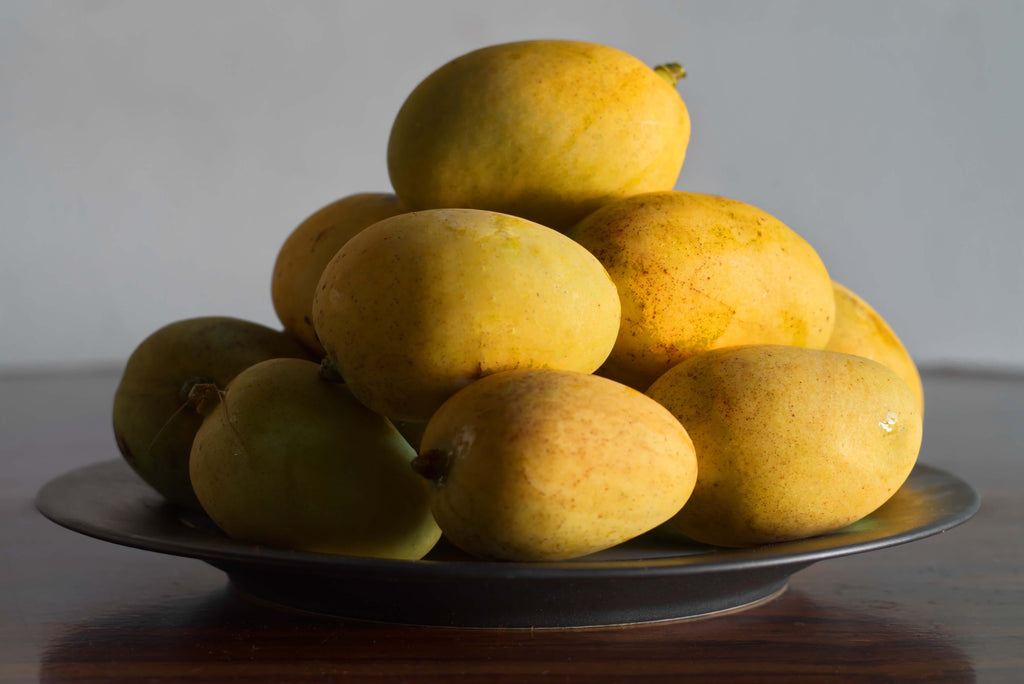
Can Dogs Eat Mango? Are They Good For Dogs?
Yes, dogs can eat mangos. Dogs love sweet treats, just like humans. Mangoes are full of nutrients beneficial to dogs and humans. If you've ever wondered if mangoes are safe for dogs, the short answer is YES.
But there are layers to this answer. You don't want to start feeding your dog massive slices of mango every day for breakfast—and definitely not every part of the mango. Let's flesh this answer out a bit more.
Benefits of Mangoes for Dogs
Mangoes are sweet, soft, fleshy, and easy for dogs to eat. This makes them a great treat or small addition to any meal. They can also get fed to dogs both big and small, old and young.
Like many other fruits and berries, mangoes also provide some nutritional benefits to your dog.
Mangoes are fat-, sodium-, and cholesterol-free. They're a fantastic source of Vitamins A, B6, C, and E, in addition to several other vitamins and minerals. Mangoes are essentially a superfood! We talk about this in our Can Dogs Eat Strawberries article.
You can give your pup mangoes both room temperature and frozen. Frozen pieces are great for cooling your dog down during the warm summer months. You can also consider dehydrating mangoes or other fruits to make a great snack on-the-go.
It's crucial for you to give your dog recommended doses of mangoes and not to feed them excess amounts. Just like us humans, everything in moderation! Depending on your dog's breed and weight, you can consult with their veterinarian about recommended doses of mango.
As we mentioned, there are some layers to this answer. Feeding your pup mangoes does come with some caveats. Here are some things to be aware of before handing your dog this tasty snack.
Potential Hazards to Feeding Your Dog Mango
Before you hand your dog a whole mango and call it a day, here are some precautions all pet owners need to know.
Don't let your dog have access to the pit of the mango.
First, for obvious reasons—the pit can be a choking hazard. If your dog accidentally swallows the pit, it may pass through easily. But, if you notice any signs of changed behavior or diet, take your dog to the vet immediately.
Second, the pit contains a small amount of cyanide, which can be terrible for your dog's digestion and overall well-being. Many seeds and pits have trace amounts of amygdalin—an organic cyanide and sugar compound which, when metabolized, degrades into hydrogen cyanide (HCN).
In most cases, unless the pit is chewed, crushed, or ground up, it should be relatively harmless. But a dog's stomach is sensitive in ways that a human's stomach is not, and they should not be given the mango pit. Regardless, the choking hazard is enough of a concern to keep it away.
Additionally, because mangoes are fibrous, this can cause digestive issues in your pup. In large doses, or on a too-consistent basis, this excess of fiber can cause stomach problems. That's why small doses in moderation are your best bet.
Too much mango can also be a concern for dental decay, as mangoes have sugars not present in regular dog food.
And lastly, the skin of the mango is hard for some dogs to digest. To prevent any digestive issues, it's best to peel any foods with skin on them. In the case of your pet, it's always better 'safe than sorry.'

How To Feed Your Dog Mango
Now that you're aware of all the benefits and potential concerns of feeding your dog mangoes, how should you go about doing so?
First is the most simple and straightforward way: giving the dogs mangoes as-is. First, peel your mango, cut it, and throw away the pit. Then, slice or dice the mango depending on the size of your dog to give them a manageable piece.
For larger dogs, more substantial pieces are okay. Since the flesh of the mango is so soft, it's easy for your pup to chew. For smaller dogs, smaller pieces are better to prevent choking hazards.
You can give your dog these pieces right away, or freeze them for a treat later! A frozen mango can cool your dog down during warmer months—plus, it keeps them occupied a little bit longer than a regular treat: a great bonus!
Another great idea is to dehydrate mangoes.
This is perfect as a snack on-the-go. Perhaps you've got a hike coming up in your future, and you want to give your dog a fun treat while walking. Dehydrated mangoes are easy to transport and keep well.
You may even be able to sneak your own bite!
Mangoes are a great idea for training your puppy, too. In minimal cuts, you can train your dog using mangoes as a positive reinforcement treat—just keep in mind the appropriate doses and caveats mentioned above.
How to Dehydrate Mango for Your Dog Treats
You can dehydrate mangoes by themselves or combine them with other delicious foods for an excellent dog treat.
The thinner the slices, the quicker the fruit will dehydrate. The thicker the slices, the longer it'll take for the fruit to dry into perfect little snacks.
First, you'll need a dehydrator.
If you soak the mangoes in a lemon bath beforehand, it can prevent browning. Peel and slice mangoes and add them into the lemon bath. You can also add other healthy fruits, like apples—just make sure you've done your research on the toxic and non-toxic options!
Take mango slices out of the lemon bath and pat them dry. Then, lay them in a single layer on the dehydrator trays. Be careful not to let the slices touch or stack on top of each other.
Set your dehydrator to about 130 degrees. For thinner slices, you'll have dehydrated mango slices in as little as four hours. Thicker slices will be ready in about 8-12 hours.
For crispier slices, keep mango in the dehydrator for longer. The chewier the slices, the quicker you'll need to feed them to your dog, as they'll turn quicker. The crispier they are, the longer they'll last.
Crispy slices should last up to two weeks in an airtight container.
If you don't have a dehydrator, you can use your oven on its lowest setting. Start checking on your treats at about the two-and-a-half-hour mark.
What Else Can I Feed My Dog?
As you can see, mangoes are a healthy, yummy treat for your dog. Never again will you have to ask, "Can dogs eat mango?"
As long as you take the proper precautions, your dogs will enjoy eating this fleshy, nutritious, sweet treat.
Vitamin Supplements for Dogs
Why do dogs need supplements? Age, environment, pollutants, and the stressors of daily life can all lead to less than optimal health for your dog. We’ve created a family of supplements to provide support in the areas your dog needs it most. Learn about Wild Earth's dog supplements.





























